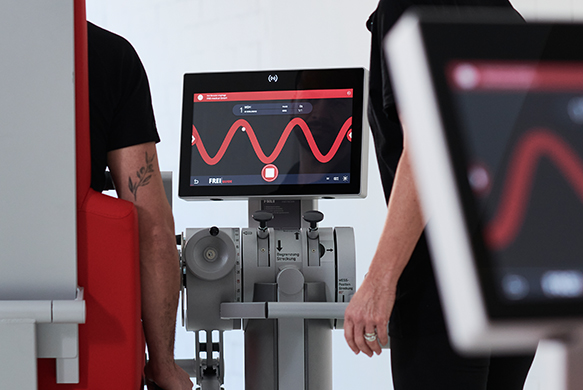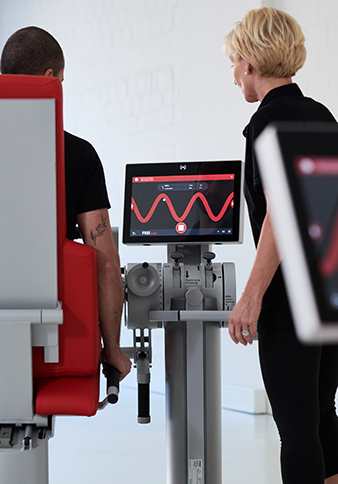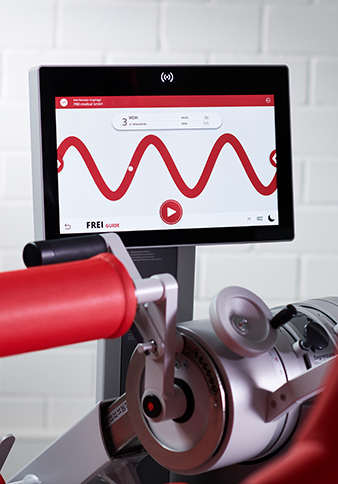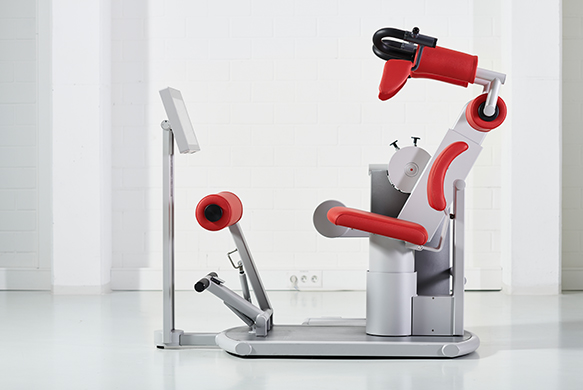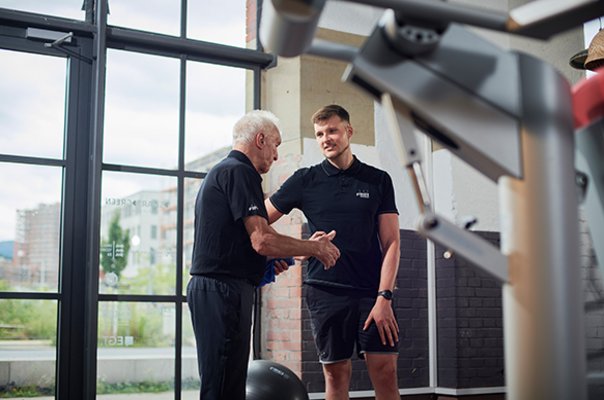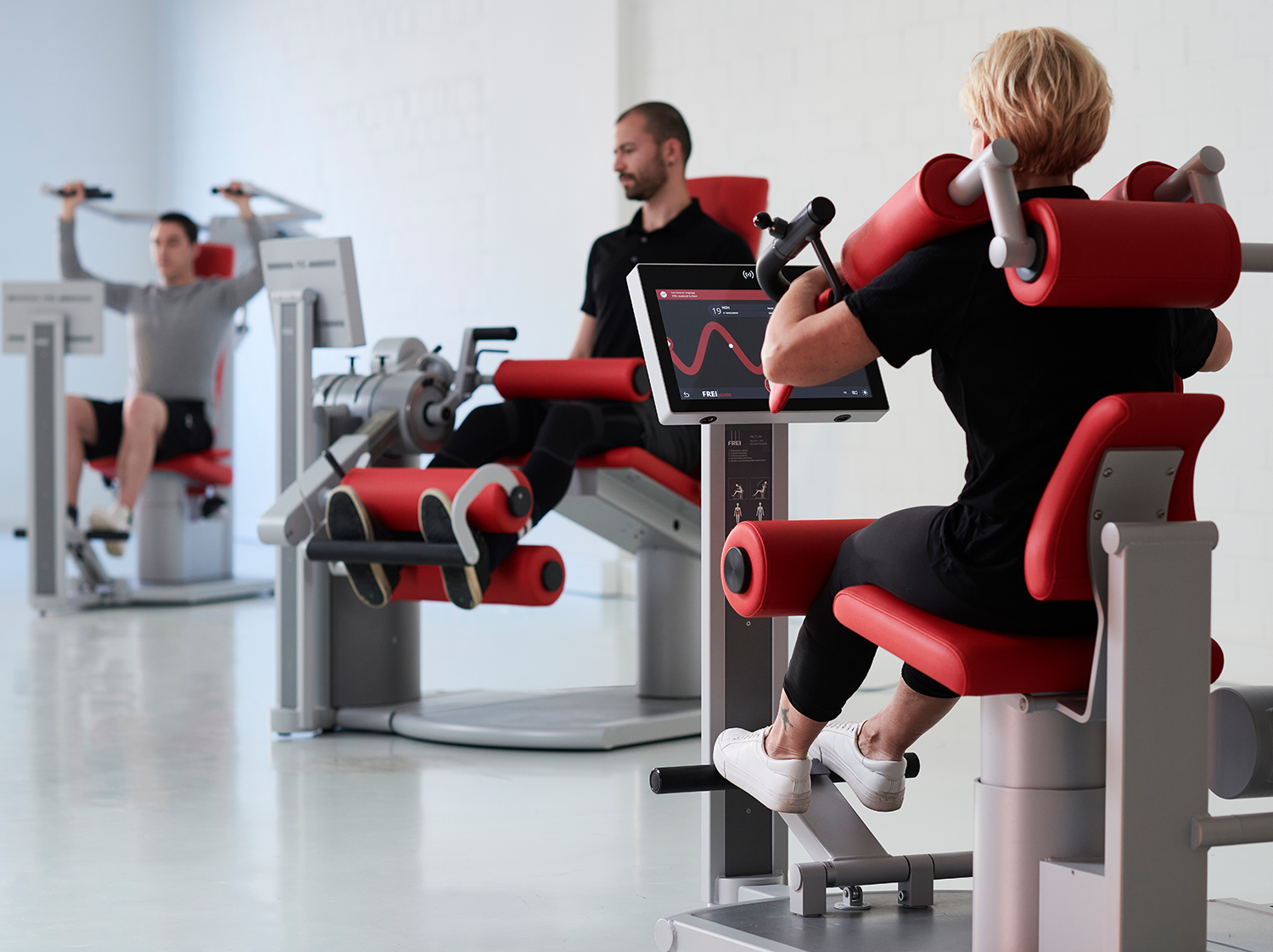
FREI GUIDE TRAINING CONTROL
FOR PLANNING, EVALUATION AND DOCUMENTATION
The new FREI GUIDE from FREI medical offers extensive isokinetic and isometric test procedures. Depending on the equipment line, dynamic auxotonic training, isokinetic and isometric training. The maximum user-friendliness enables individual training at the optimal point of challenge.
A NEW DIMENSION IN TRAINING CONTROL & EVALUATION!
INDIVIDUAL TRAINING CONTROL AT THE Optimal point of Challenge
DIFFERENT TEST METHODS CAN BE USED DEPENDING ON THE FACTUM® OR GENIUS ECO® DEVICE LINE
Isokinetic test for the line of FACTUM® devices
The isokinetic test allows the determination of maximum torque/force development during dynamic repetitions. At a given angular velocity, the FREI GUIDE determines force-angle curves in isokinetic mode, which determine the force developed in the various angular positions. The therapist/trainer gains objective information about the performance of the patient/client via the display of left-right comparisons or muscle strength ratios of agonist/antagonist, which can then be taken into account in subsequent training. As part of the therapy, the isokinetic test also allows conclusions to be drawn about any remaining complaints or pain that occur during the test. Functional disorders of the joint mechanics can thus be identified and assigned to specific angular ranges. Muscular deficits and imbalances are determined and can be addressed accordingly in the training program. The comparison of initial test and re-test enables the presentation and objectification of therapy and training progress.
Isometric test
The isometric test is a static test to determine maximum strength capabilities and can be performed in one or more angular positions. As with the isokinetic test, the test results obtained allow statements to be made about individual performance and existing deficits in strength development and muscle strength ratios. The effectiveness of the therapy and training measures can be documented by comparing isometric initial and follow-up tests.
Test to determine the individual movement amplitude
The test to determine the individual movement amplitude determines the individual start and end point of the movement on the training device. The start and end points of the movement on the respective training device determined in the test are transferred to the selected feedback display during training.
Submaximal test for the line of GENIUS ECO® devices
In the submaximal test, the 1-repetition-maximum strength is derived from the number of repetitions completed in the submaximal range. The submaximal test is particularly suitable for patients and clients for whom a maximum strength test cannot be carried out due to limited resilience, existing discomfort or pain.
DIFFERENT TRAINING PHASES CAN BE USED, DEPENDING ON THE FACTUM® OR GENIUS ECO® DEVICE LINE
In addition to the classic dynamic, so-called auxotonic resistance training with a specified training load on the GENIUS ECO® devices or training resistance on the FACTUM® devices, training with the FREI Guide also enables isometric and isokinetic training on the FACTUM® devices. Depending on the training goal and depending on the therapy and training phase, different forms of training can be used.
Dynamic auxotonic training
When training in auxotonic mode, the resistance or training load is kept constant while the speed of movement varies. In this mode, the patient/customer is shown default curves via real-time feedback, which keep the speed of movement as constant as possible over the entire range of movement in order to avoid stress peaks.
Isokinetic training on the FACTUM® line of devices
In contrast to auxotonic training, in isokinetic mode the speed is kept constant during the movement, while the possible power development varies. Depending on the level of performance and symptoms, the patient/customer can use more or less force or increase the force development slowly and continuously. Overloading can be avoided and the training can always be adapted to the level of performance. Isokinetic training is used in therapy to get patients used to the training process slowly and in a controlled manner after injuries and operations or in the case of neurological diseases and to gently build up neuromuscular performance. Isokinetic training is used in performance training because it builds muscle strength particularly effectively - the muscular system can be optimally utilized in the isokinetic training mode at any joint angle. During isokinetic training, the FREI Guide displays default curves in real-time feedback, which - unlike in auxotonic training - show the use of force over the movement path and thus optimally control the intensity of the training.
Isometric Training
In isometric training, static muscle contractions are performed in defined angular positions. Isometric training is used in particular in the early phase of therapy, when dynamic training movements over a larger range of motion are not yet possible or are not desired or permitted. The use of isometric training is also useful for particularly fragile patients with low physical capacity: isometric preparation exercises can be used to relearn how to develop muscular tension before dynamic forms of training can also be used in the further training process. If there are muscular deficits in certain angular ranges, isometric training can effectively build up strength in these positions. During the isometric training, default curves are displayed that represent the intensity of the force at the time of the contraction and are to be traced as precisely as possible in order to optimize muscle strength and movement control.
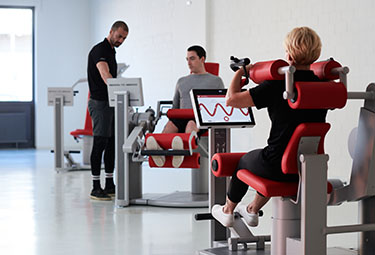
Different levels of difficulty can be selected for the various biofeedback displays in order to challenge the patients/customers at any time according to their performance:
- Standard
- Advanced
- Professional
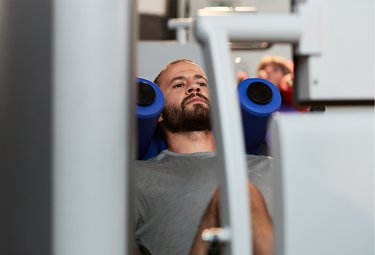
- Curve display: During training, sine curves are displayed, which specify the range of motion and speed of the training and which the trainee should follow as closely as possible.
- Bar Graph: In the bar graph, the task is to keep a ball in a moving field during training. The start and end point of the movement are defined by the length of the bar, the movement speed is kept constant over the moving field.
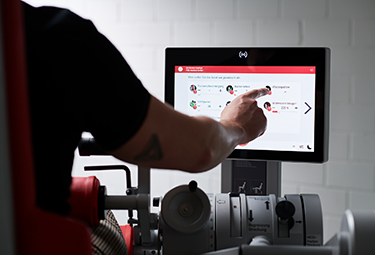
The so-called coordination index shows how well the movement task is solved via the feedback representations During the ongoing training, the user can use the coordination index to track how precisely the movement speed is maintained within the specified range of movement and in the different training phases concentrically/eccentrically or how large the deviations are when following in curve, bar or game mode. At the end of the training, the result of the coordination index is displayed differentiated for agonist/antagonist (training with FACTUM®) or concentric/eccentric training phase (training with GENIUS ECO®) and saved with the training carried out.

